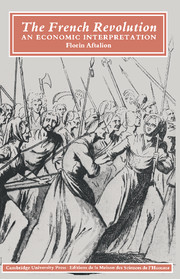Book contents
- Frontmatter
- Contents
- List of figures
- Chronology
- Acknowledgements
- Introduction
- 1 The fiscal crisis
- 2 The French economy at the end of the ‘Ancien Régime’
- 3 1789
- 4 The ‘assignats’
- 5 The finances of the Constituent Assembly
- 6 The rising cost of living, anarchy and war
- 7 The seizure of power by the Mountain
- 8 Economic dictatorship
- 9 ‘Dirigisme’ in retreat
- 10 The French Revolution: economic considerations
- Appendices
- Notes
- Select guide to further reading
- Index
- Frontmatter
- Contents
- List of figures
- Chronology
- Acknowledgements
- Introduction
- 1 The fiscal crisis
- 2 The French economy at the end of the ‘Ancien Régime’
- 3 1789
- 4 The ‘assignats’
- 5 The finances of the Constituent Assembly
- 6 The rising cost of living, anarchy and war
- 7 The seizure of power by the Mountain
- 8 Economic dictatorship
- 9 ‘Dirigisme’ in retreat
- 10 The French Revolution: economic considerations
- Appendices
- Notes
- Select guide to further reading
- Index
Summary
The Constituent Assembly had taken three crucial decisions in 1789. No sooner was it established than it de facto relinquished the right to collect the taxes of the Ancien Régime, while at the same time it announced that it would honour all past debts. At the end of the year, the assignats – in their first form, as state bonds – would, it was hoped, open up new opportunities for borrowing. The Treasury's financial difficulties were thus exacerbated, for the first of these decisions further reduced the state's already inadequate fiscal revenues, the second maintained in existence the heavy burden of the royal debt, whereas the third could only yield fairly limited resources.
In this situation, there was only a limited number of possible choices. The Treasury could, for example, levy the necessary taxes. Since the Revolution had been made precisely in order to oppose taxation, this possibility was never even entertained. The Treasury could, on the other hand, postpone settling up with its creditors until the advent of better days, but such a decision would certainly cause grave displeasure to the latter, and furthermore could not be regarded as a lasting solution while the country's finances were in disarray. Thirdly and lastly, it could persevere with the time-honoured method of borrowing heavily and settling old debts with what the new ones yielded, but public opinion was concerned that there be some change in policy.
Information
- Type
- Chapter
- Information
- The French RevolutionAn Economic Interpretation, pp. 68 - 85Publisher: Cambridge University PressPrint publication year: 1990
